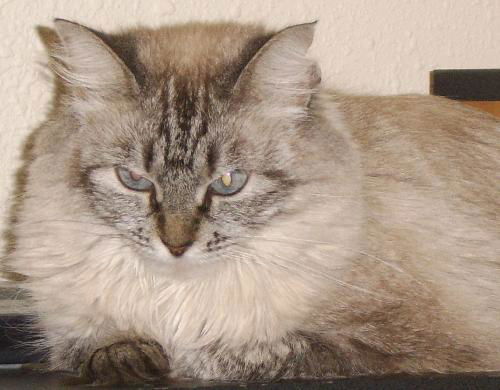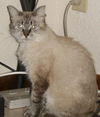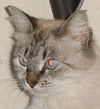Welcome to Pet Rescue By Judy!
401 South Laurel Avenue
Sanford, FL 32771
(407) 302-4497
info@petrescuebyjudy.com
Windy the Birman's Web Page

| My Rescue |
| Login to Remember your Favorite Animals and Breeds! |
Name: Windy the Birman
Status: Adopted!
Adoption Fee: $150
Species: Cat
Breed: Birman (medium coat)
Color: Cream and Brown
Pattern: Tabby
Sex: Female (spayed)
Current Size: 8 Pounds
General Potential Size: Medium
Current Age: 20 Years 8 Months (best estimate)
Activity Level: Moderately Active
Indoor or Outdoor: Indoor Only
Good with Dogs: Yes
Good with Cats: Yes
Housetrained: Yes
Microchipped: Yes
Description:
Windy is a lovely, exotic tabby-point Birman. She was found living on her own and was initially untrusting of people. Since she was most likely abandoned by one, who can blame her? But Bobby has been working with her and she has demonstrated that she is very sweet once she trusts you. Thank you Bobby ~ you're a patient man!!! Windy will need a lot of patience from her new family sine she is still rather scared, but I think it's worth it. I have a Bengal cat who came to me from a similar situation. We let her come at her own pace, which wasn't super fast, but it was worth it. I think you will find the same is true for Windy!!!
01/13/2008 Foster Update:
Windy has really come around and loves to talk and talk to you. I have finally earned her trust and she will let me pet her now! I have found that catnip is her all time favorite and she will grab her toy and rub it all over her face! I sit there in awe of her beauty and watch her act so silly with the catnip you just want to pick her up and squeeeeeze her!
According to www.cat-lovers-only.com, many people think that the beautiful Birman breed originated from cats that guarded the Burman temples.
This breed is even rumored to have helped the Burmese monks fight off attackers. During that time, as the story goes, a Birman's coat turned the golden color of the goddess the monks worshiped, except for his paws which stayed pure white. Of course, less fanciful cat lovers say the Birman is simply a French relative of the Himalayan cat breed.
Although no one is completely sure where the Birman breed came from, all cat fanciers agree that it is definitely an older breed. Some breeders say the Birman is closely related to the Siamese cat, since it resembles a slightly stockier Siamese in appearance.
In fact, more than one person has said that when the pure white Burman temple cats changed color, it was probably because a stray Siamese cat fathered a few litters of kittens.
In the nineteen twenties, the Birman cat reached Europe. A single female survived the long voyage from Burma to France and gave birth to a female kitten who is the ancestor of today's Birman cats. This cat was most likely crossed with a Siamese cat.
After World War II, the Birman was in grave danger of extinction, as only one known pair of Birmans had survived the German occupation. The breed was again outcrossed with another cat to avoid extinction, although this time the Persian was most likely used.
With all of the inbreeding that was done to save the Birman breed, it would be no surprise if these cats were prone to several hereditary diseases. However, the breed is surprisingly healthy overall.
You should be aware that most of the members of the Birman cat breed are prone to anesthesia sensitivity. Add this to the fact that Birmans can be either A or B blood type, and this can mean trouble on the operating table. The breed is also prone to developing hairballs.
Since Birmans are prone to hairballs, you may want to feed your cat a diet that is formulated to aid in hairball prevention. If he becomes lethargic and does not eat as much as he normally does, you should consult your veterinarian about treating him for hairballs.
Since this breed is not as active as some other breeds, you may also need to ask your veterinarian about feeding your cat a weight control diet if he becomes overweight.
While this breed is a longhair breed, it does not have a heavy coat. As long as you comb your Birman's hair once a week, you should not have a problem with the coat matting. Hairball control is another matter, and more frequent grooming can go a long way in helping with that problem.
These cats are still somewhat playful, curious and affectionate, like their Siamese relatives, but are more laid back and relaxed than the Siamese, like their Persian relatives.
If you are looking for a cat that isn't quite as demanding and attention seeking as some of the more affectionate breeds, but also isn't too standoffish, the Birman cat breed is a good choice.
01/13/2008 Foster Update:
Windy has really come around and loves to talk and talk to you. I have finally earned her trust and she will let me pet her now! I have found that catnip is her all time favorite and she will grab her toy and rub it all over her face! I sit there in awe of her beauty and watch her act so silly with the catnip you just want to pick her up and squeeeeeze her!
According to www.cat-lovers-only.com, many people think that the beautiful Birman breed originated from cats that guarded the Burman temples.
This breed is even rumored to have helped the Burmese monks fight off attackers. During that time, as the story goes, a Birman's coat turned the golden color of the goddess the monks worshiped, except for his paws which stayed pure white. Of course, less fanciful cat lovers say the Birman is simply a French relative of the Himalayan cat breed.
Although no one is completely sure where the Birman breed came from, all cat fanciers agree that it is definitely an older breed. Some breeders say the Birman is closely related to the Siamese cat, since it resembles a slightly stockier Siamese in appearance.
In fact, more than one person has said that when the pure white Burman temple cats changed color, it was probably because a stray Siamese cat fathered a few litters of kittens.
In the nineteen twenties, the Birman cat reached Europe. A single female survived the long voyage from Burma to France and gave birth to a female kitten who is the ancestor of today's Birman cats. This cat was most likely crossed with a Siamese cat.
After World War II, the Birman was in grave danger of extinction, as only one known pair of Birmans had survived the German occupation. The breed was again outcrossed with another cat to avoid extinction, although this time the Persian was most likely used.
With all of the inbreeding that was done to save the Birman breed, it would be no surprise if these cats were prone to several hereditary diseases. However, the breed is surprisingly healthy overall.
You should be aware that most of the members of the Birman cat breed are prone to anesthesia sensitivity. Add this to the fact that Birmans can be either A or B blood type, and this can mean trouble on the operating table. The breed is also prone to developing hairballs.
Since Birmans are prone to hairballs, you may want to feed your cat a diet that is formulated to aid in hairball prevention. If he becomes lethargic and does not eat as much as he normally does, you should consult your veterinarian about treating him for hairballs.
Since this breed is not as active as some other breeds, you may also need to ask your veterinarian about feeding your cat a weight control diet if he becomes overweight.
While this breed is a longhair breed, it does not have a heavy coat. As long as you comb your Birman's hair once a week, you should not have a problem with the coat matting. Hairball control is another matter, and more frequent grooming can go a long way in helping with that problem.
These cats are still somewhat playful, curious and affectionate, like their Siamese relatives, but are more laid back and relaxed than the Siamese, like their Persian relatives.
If you are looking for a cat that isn't quite as demanding and attention seeking as some of the more affectionate breeds, but also isn't too standoffish, the Birman cat breed is a good choice.
Video of Windy the Birman:

Other Pictures of Windy the Birman (click to see larger version):
 31k |
 33.4k |
 43.1k |
 24.1k |
 34.4k |
 33.4k |
 37.6k |
Copyright © Pet Rescue by Judy





